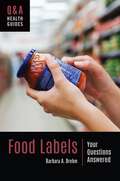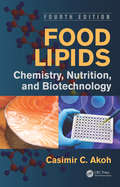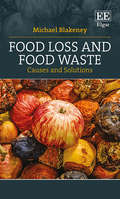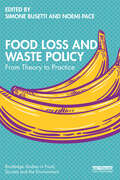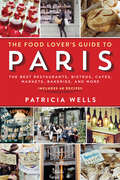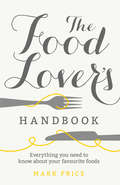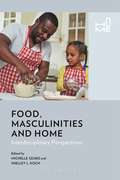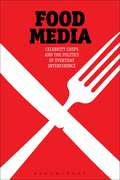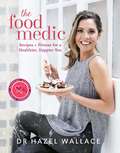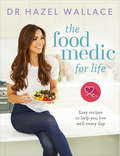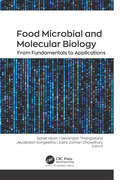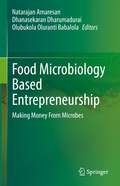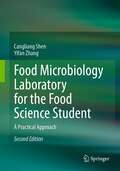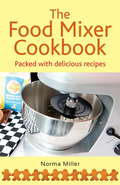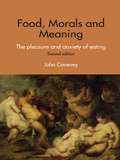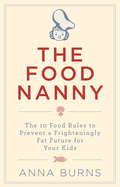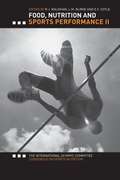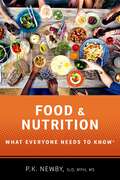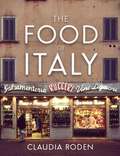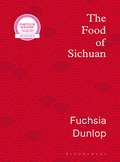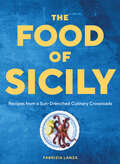- Table View
- List View
Food Labels: Your Questions Answered (Q&A Health Guides)
by Barbara A. BrehmThis book provides an approachable introduction to food labels. While aimed primarily at teens and young adults, it is a valuable tool for anyone who wants to better understand what food labels are really saying and make healthy food choices.How accurate is the Nutrition Facts Panel, and who decides what information goes on it? Why don't all foods have nutrition or ingredient information? How can you tell if a product is organic, non-GMO, or ethically produced? Are words such as "all-natural" and "light" on packaging meaningful or just clever marketing? Food Labels: Your Questions Answered, a part of Greenwood's Q&A Health Guides series, provides clear, concise answers to these and many other questions readers may have about the labels and health claims found on food packaging.Each book in this series follows a reader-friendly question-and-answer format that anticipates readers' needs and concerns. Prevalent myths and misconceptions are identified and dispelled, and a collection of case studies illustrates key concepts and issues through relatable stories and insightful recommendations. The book also includes a section on health literacy, equipping teens and young adults with practical tools and strategies for finding, evaluating, and using credible sources of health information both on and off the internet—important skills that contribute to a lifetime of healthy decision-making.
Food Lipids: Chemistry, Nutrition, and Biotechnology, Fourth Edition
by Casimir C. AkohMaintaining the high standards that made the previous editions such well-respected and widely used references, Food Lipids: Chemistry, Nutrition, and Biotechnology, Fourth Edition provides a new look at lipid oxidation and highlights recent findings and research. Always representative of the current state of lipid science, this edition provides 16 new chapters and 21 updated chapters, written by leading international experts, that reflect the latest advances in technology and studies of food lipids.New chapters Analysis of Fatty Acid Positional Distribution in Triacylglycerol Physical Characterization of Fats and Oils Processing and Modification Technologies for Edible Oils and Fats Crystallization Behavior of Fats: Effect of Processing Conditions Enzymatic Purification and Enrichment and Purification of Polyunsaturated Fatty Acids and Conjugated Linoleic Acid Isomers Microbial Lipid Production Food Applications of Lipids Encapsulation Technologies for Lipids Rethinking Lipid Oxidation Digestion, Absorption and Metabolism of Lipids Omega-3 Polyunsaturated Fatty Acids and Health Brain Lipids in Health and Disease Biotechnologically Enriched Cereals with PUFAs in Ruminant and Chicken Nutrition Enzyme-Catalyzed Production of Lipid Based Esters for the Food Industry: Emerging Process and Technology Production of Edible Oils Through Metabolic Engineering Genetically Engineered Cereals for Production of Polyunsaturated Fatty Acids The most comprehensive and relevant treatment of food lipids available, this book highlights the role of dietary fats in foods, human health, and disease. Divided into five parts, it begins with the chemistry and properties of food lipids covering nomenclature and classification, extraction and analysis, and chemistry and function. Part II addresses processing and food applications including modification technologies, microbial production of lipids, crystallization behavior, chemical interesterification, purification, and encapsulation technologies. The third part covers oxidation, measurements, and antioxidants. Part IV explores the myriad interactions of lipids in nutrition and health with information on heart disease, obesity, and cancer, with a new chapter dedicated to brain lipids. Part V continues with contributions on biotechnology and biochemistry including a chapter on the metabolic engineering of edible oils.
Food Lipids: Chemistry, Nutrition, and Biotechnology, Fourth Edition
by Casimir C. AkohMaintaining the high standards that made the previous editions such well-respected and widely used references, Food Lipids: Chemistry, Nutrition, and Biotechnology, Fourth Edition provides a new look at lipid oxidation and highlights recent findings and research. Always representative of the current state of lipid science, this edition provides 16 new chapters and 21 updated chapters, written by leading international experts, that reflect the latest advances in technology and studies of food lipids.New chapters Analysis of Fatty Acid Positional Distribution in Triacylglycerol Physical Characterization of Fats and Oils Processing and Modification Technologies for Edible Oils and Fats Crystallization Behavior of Fats: Effect of Processing Conditions Enzymatic Purification and Enrichment and Purification of Polyunsaturated Fatty Acids and Conjugated Linoleic Acid Isomers Microbial Lipid Production Food Applications of Lipids Encapsulation Technologies for Lipids Rethinking Lipid Oxidation Digestion, Absorption and Metabolism of Lipids Omega-3 Polyunsaturated Fatty Acids and Health Brain Lipids in Health and Disease Biotechnologically Enriched Cereals with PUFAs in Ruminant and Chicken Nutrition Enzyme-Catalyzed Production of Lipid Based Esters for the Food Industry: Emerging Process and Technology Production of Edible Oils Through Metabolic Engineering Genetically Engineered Cereals for Production of Polyunsaturated Fatty Acids The most comprehensive and relevant treatment of food lipids available, this book highlights the role of dietary fats in foods, human health, and disease. Divided into five parts, it begins with the chemistry and properties of food lipids covering nomenclature and classification, extraction and analysis, and chemistry and function. Part II addresses processing and food applications including modification technologies, microbial production of lipids, crystallization behavior, chemical interesterification, purification, and encapsulation technologies. The third part covers oxidation, measurements, and antioxidants. Part IV explores the myriad interactions of lipids in nutrition and health with information on heart disease, obesity, and cancer, with a new chapter dedicated to brain lipids. Part V continues with contributions on biotechnology and biochemistry including a chapter on the metabolic engineering of edible oils.
Food Loss and Food Waste: Causes and Solutions
by Michael BlakeneyGlobal food insecurity is a growing issue. At a time when the world’s population is increasing and agricultural production is challenged by climate change, it is estimated that around a third of the food produced globally is lost or wasted. This book examines the problem of food loss and waste (FLW) and the policies that could be enacted to remedy this fundamental global concern. Michael Blakeney provides a well-rounded view of FLW from production to plate. He begins by examining the problems associated with defining and measuring food waste, arguing that more reliable data on FLW is key to the creation of effective FLW reduction policies. He goes on to address the drivers of FLW, the environmental impacts of FLW and the moral and ethical considerations that are linked to the issue. Food Loss and Waste concludes with a critical assessment of FLW reduction strategies across the food supply chain. Providing the first comprehensive assessment of FLW and its remedies, this book will be of great interest to scholars working in the fields of food security, agricultural law and policy and rural economics. Policy makers involved in food policy and security will also find this a valuable resource as it identifies and analyses FLW policies on an international scale.
Food Loss and Waste Policy: From Theory to Practice (Routledge Studies in Food, Society and the Environment)
by Simone Busetti Noemi PaceThis book examines policy responses to food waste and loss, an issue of significant, global concern, with one-third of food produced for human consumption lost or wasted. Investigating food waste and loss under an interdisciplinary lens, the contributors employ a variety of methodological approaches, including quantitative and qualitative techniques, drawing on in-depth case studies and action research. The volume is organised into four parts: Understanding Food Loss and Waste, International Programmes, National Policies and Local Initiatives. The first part introduces the reader to the concept of food loss and waste, how it can be measured, its causes and consequences, and how it can be reduced. The second part is dedicated to international and cross-country case studies, with six chapters reviewing national policies implemented in France, Italy, Romania, Japan, China and the United States. In Part Four, three chapters are dedicated to local food recovery and redistribution initiatives. By focusing on different territories and different levels of governance, the book provides a detailed evaluation of food loss and waste policies, the barriers and opportunities of implementing the policies, as well as the impact they are actually having. The chapters are both descriptive and evaluative and draw out lessons for designing, implementing and reforming programmes. This book will be of great interest to students and scholars working on food waste, food policy, sustainable food systems, agricultural production and supply chains and public policy, as well as policymakers involved with developing and implementing programmes and policies to regulate and reduce food waste and loss.
Food Loss and Waste Policy: From Theory to Practice (Routledge Studies in Food, Society and the Environment)
by Simone Busetti Noemi PaceThis book examines policy responses to food waste and loss, an issue of significant, global concern, with one-third of food produced for human consumption lost or wasted. Investigating food waste and loss under an interdisciplinary lens, the contributors employ a variety of methodological approaches, including quantitative and qualitative techniques, drawing on in-depth case studies and action research. The volume is organised into four parts: Understanding Food Loss and Waste, International Programmes, National Policies and Local Initiatives. The first part introduces the reader to the concept of food loss and waste, how it can be measured, its causes and consequences, and how it can be reduced. The second part is dedicated to international and cross-country case studies, with six chapters reviewing national policies implemented in France, Italy, Romania, Japan, China and the United States. In Part Four, three chapters are dedicated to local food recovery and redistribution initiatives. By focusing on different territories and different levels of governance, the book provides a detailed evaluation of food loss and waste policies, the barriers and opportunities of implementing the policies, as well as the impact they are actually having. The chapters are both descriptive and evaluative and draw out lessons for designing, implementing and reforming programmes. This book will be of great interest to students and scholars working on food waste, food policy, sustainable food systems, agricultural production and supply chains and public policy, as well as policymakers involved with developing and implementing programmes and policies to regulate and reduce food waste and loss.
The Food Lover's Guide to Paris: The Best Restaurants, Bistros, Cafés, Markets, Bakeries, and More
by Patricia WellsThe book that cracks the code, from the incomparable Patricia Wells. An acclaimed authority on French cuisine, Ms. Wells has spent more than 30 years in Paris, many as former restaurant critic for The International Herald Tribune. Now her revered Food Lover’s Guide to Paris is back in a completely revised, brand-new edition. In 457 entries—345 new to this edition, plus 112 revisited and reviewed classics—The Food Lover’s Guide to Paris offers an elegantly written go-to guide to the very best restaurants, cafés, wine bars, and bistros in Paris, as well as where to find the flakiest croissants, earthiest charcuteries, sublimest cheese, most ethereal macarons, and impeccable outdoor markets. The genius of the book is Ms. Wells’s meritocratic spirit. Whether you’re looking for a before-you-die Michelin three-star experience (Guy Savoy, perhaps, or Restaurant Alain Ducasse au Plaza Athénée) or wanting to sample the new bistronomy (Bistrot Paul Bert, Le Comptoir du Relais) or craving something simple and perfect (L’As du Fallafel, or Breizh Café for crêpes), Patricia Wells tells you exactly where to go and why you should go there. You no longer have to rely on the iffy “reviews” of Yelp or Trip Advisor. Included are 40 recipes from some of her favorite chefs and purveyors and, of course, all the practical information: addresses, websites, email, hours, closest métro stop, specialties, and more.
The Food Lover's Handbook
by Mark PriceIn this beautifully illustrated handbook, food expert Mark Price shines the spotlight on 40 of the most popular foods – from everyday items like tea, coffee and cheese, to luxury products like caviar and chocolate. A timely and topical guide for foodies and everyday shoppers, this book dispels unhelpful food myths and provides fact-based, unbiased accounts of where food comes from, the morals behind different production methods, and why prices and taste vary. This book will equip readers and shoppers with the tools they need to be able to make informed decisions about what to buy and how much to spend.Standing apart from subjective discussions about taste, and debates around health and nutrition, this book clearly and concisely explains why the cheapest to the most expensive foods cost what they do.Peppered throughout with first-hand experience and anecdotes, Mark Price goes back to the origins of these items, their historical significance and perceived value in today’s society, and advice on the products you should ‘try before you die’!
Food, Masculinities, and Home: Interdisciplinary Perspectives (Home)
by Michelle Szabo Shelley Koch Rosie Cox Victor BuchliLong-held associations between women, home, food, and cooking are beginning to unravel as, in a growing number of households, men are taking on food and cooking responsibilities. At the same time, men's public foodwork continues to gain attention in the media and popular culture. The first of its kind, Food, Masculinities and Home focuses specifically on food in relation to how homemaking practices shape masculine identities and transform meanings of 'home'. The international, multidisciplinary contributors explore questions including how food practices shape masculinity and notions of home, and vice versa; the extent to which this gender shift challenges existing gender hierarchies; and how masculinities are being reshaped by the growing presence of men in kitchens and food-focused spaces.With ever-growing interest in both food and gender studies, this is a must-read for students and researchers in food studies, gender studies, cultural studies, sociology, geography, anthropology, and related fields.
Food Media: Celebrity Chefs and the Politics of Everyday Interference (Rowman And Littlefield Studies In Food And Gastronomy Ser.)
by Signe RousseauThere have been famous chefs for centuries. But it was not until the second half of the twentieth century that the modern celebrity chef business really began to flourish, thanks largely to advances in media such as television which allowed ever-greater numbers of people to tune in. Food Media charts the growth of this enormous entertainment industry, and also how, under the threat of the obesity "epidemic," some of its stars have taken on new authority as social activists, while others continue to provide delicious distractions from a world of potentially unsafe food. The narrative that joins these chapters moves from private to public consumption, and from celebrating food fantasies to fueling anxieties about food realities, with the questionable role of interference in people's everyday food choices gaining ground along the way.Covering celebrity chefs such as Jamie Oliver and Rachael Ray, and popular trends like foodies, food porn and fetishism, Food Media describes how the intersections between celebrity culture and food media have come to influence how many people think about feeding themselves and their families - and how often that task is complicated when it need not be.
The Food Medic: Recipes & Fitness for a Healthier, Happier You
by Dr Hazel WallaceJunior Doctor, personal trainer and Instagram hit Dr Hazel Wallace's first book brings you over 70 nutritional recipes to look and feel amazing whilst debunking the diet myths. 'I'm a girl who juggles two jobs, who loves to lift, who adores real food - and can't resist chocolate.As a junior doctor and a personal trainer, I know that we all feel our best when we are free of illness, full of energy and at a healthy weight - and I know it can be done, even if you lead the busiest of lives!I want to debunk the myths that are out there surrounding dieting and instead offer solid, evidence-based advice.I want to bridge the gap between mainstream medicine and nutrition and help you take full control of your fitness and wellbeing, so you will never have to diet again.I want to show you that eating the most natural, unrefined and unprocessed wholefood ingredients can be enjoyable, uncomplicated and easy to incorporate into a busy lifestyle.I want this book to change your life.'Hazel x
The Food Medic for Life: Easy recipes to help you live well every day
by Dr Hazel WallaceAs someone who juggles many jobs between being a doctor, a personal trainer and an author, I understand how difficult it can be to prioritise food and eating well.I wanted to create a collection of beautiful recipes that are not only nutritious and great tasting, but super quick and simple to make, using only a handful of ingredients. The Fuel Up section is designed for just that - it is where you will find my recipes for grab-and-go breakfasts, lunches on the run and dinners that take less than 30 minutes to satisfy you after a long day at work! However, I truly believe that when we do have the time to cook a meal, bake some bread and sit down with friends and family to share some food, we should totally embrace those moments. This is where the Power Down section comes in: for when you're not in a hurry, I have included my chosen recipes for lazy weekend brunches, family dinners, breads and teatime treats. This is a cookbook that will help you fall in love with cooking and improve your relationship with food, so that you approach it not only as a source of nutrients, but also happiness, satisfaction and health.Hazel xIncludes more than 100 recipes PLUS:- 10 'no recipe recipes' for emergency snacks + meal prep hacks for maintaining a healthy lifestyle when you're busy- an introduction to Hazel's five store-cupboard saviours, including 10 ways to cook with each one- a key for special dietary requirements including vegetarian, vegan, gluten-free and low sugar- nutritional advice covering the basics of nutrition, how to meet your 5-a-day and special nutritional requirements for a plant-based diet- features on how to live well for optimum health, with information on sleep, meditation, mindfulness and mindful eating
Food Microbial and Molecular Biology: From Fundamentals to Applications
by Saher Islam Devarajan Thangadurai Jeyabalan Sangeetha Zaira Zaman ChowdhuryThe ever-increasing globalization of the food industry demands new interventions and prevention technologies to improve the safety and quality of food. This multidisciplinary new book presents advanced systems for identifying, analyzing, tracking, and monitoring microbial contaminants in food.Key features:• Highlights emerging and re-emerging foodborne microorganisms and their virulence characteristics• Includes recent approaches for food quality assurance and risk management• Describes the practicality of molecular biology and microbial technologies for effectual control of foodborne infections• Presents a detailed overview of the utilization of recent molecular techniques in food microbiologyWith expert contributions from experienced academics involved in food microbiology and molecular biology research, this book offers indispensable guidance and a contemporary update of the latest developments in food microbial and molecular biology.
Food Microbial and Molecular Biology: From Fundamentals to Applications
by Saher Islam Devarajan Thangadurai Jeyabalan Sangeetha Zaira Zaman ChowdhuryThe ever-increasing globalization of the food industry demands new interventions and prevention technologies to improve the safety and quality of food. This multidisciplinary new book presents advanced systems for identifying, analyzing, tracking, and monitoring microbial contaminants in food.Key features:• Highlights emerging and re-emerging foodborne microorganisms and their virulence characteristics• Includes recent approaches for food quality assurance and risk management• Describes the practicality of molecular biology and microbial technologies for effectual control of foodborne infections• Presents a detailed overview of the utilization of recent molecular techniques in food microbiologyWith expert contributions from experienced academics involved in food microbiology and molecular biology research, this book offers indispensable guidance and a contemporary update of the latest developments in food microbial and molecular biology.
Food Microbiology Based Entrepreneurship: Making Money From Microbes
by Natarajan Amaresan Dhanasekaran Dharumadurai Olubukola Oluranti BabalolaThis book is first part of the 3 volume set focusing on basic and advanced methods for using microbiology as an entrepreneurial venture. This book deals with the concept of entrepreneurship skills for production, cost-benefit analysis and marketing of button, oyster, milky mushroom, Ganoderma sp, Single cell protein, Breads, Cheese, Yoghurt, Wine, Beer, Probiotics, Prebiotics fermented vegetables, and Fermented Fish etc. Chapters cover the applications of microorganisms in small and large scale production to achieve a sustainable output. This book provides essential knowledge and working business protocols from all related disciplines of food and dairy industry, probiotics industry, mushroom industry, beverage and baking industry, poultry industry, and aquaculture industry etc. This book is useful to graduate students, research scholars and postdoctoral fellows, and teachers who belong to different disciplines via botany, food microbiology, biotechnology, aquaculture microbiology and poultry microbiology. The other two volumes are focused on agriculture and industrial microbiology.
Food Microbiology Laboratory for the Food Science Student: A Practical Approach
by Cangliang Shen Yifan ZhangThis book is designed to give students an understanding of the role of microorganisms in food processing and preservation; the relation of microorganisms to food spoilage, foodborne illness, and intoxication; general food processing and quality control; the role of microorganisms in health promotion; and federal food processing regulations. The listed laboratory exercises are aimed to provide a hands-on-opportunity for the student to practice and observe the principles of food microbiology. Students will be able to familiarize themselves with the techniques used to research, regulate, prevent, and control the microorganisms in food and understand the function of beneficial microorganism during food manufacturing process. The second edition add 5 new chapters including “Chapter 10 -Thermal inactivation of Escherichia coli O157:H7 in mechanically tenderized beef steaks and color measurements”, “Chapter 11-Evaluate antimicrobial activity of chlorine water on apples and measurement of free chlorine concentrations”, “Chapter 12-Evaluate cross-contamination of Salmonella on tomatoes in wash water using most probable number (MPN) technique”, “Chapter 15-DNA extraction and purity determination of foodborne pathogens”, and “Chapter 16-Practice of multiplex PCR to identify bacteria in bacterial solutions”. It also includes new lab work flowcharts for Gram-staining and endospore-staining technology in Chapter 1, pour plating and spread plating in Chapter 3, Enterotube II in Chapter 9, and Kirby Beau test procedure in Chapter 20. It includes a new sample of syllabus with the hybrid teaching of both lecture and lab sections in one course, which will assist junior faculty/instructors to develop similar lecture and lab courses.
The Food Mixer Cookbook: Packed With Delicious Recipes
by Norma MillerHome-made food has so many attractions. With your food mixer to hand, cakes and pastries, pies and tarts, sweet and savoury fillings and lots more besides, are quick, easy and fun to make. Children will love joining in with weighing ingredients and decorating the finished product. A food mixer also means much more control over the choice and quality of ingredients.Discover how to exploit this handy kitchen aid to its full potential, using the versatility of the food mixer's three blades and their functions to whisk, whip, knead and mix.There is a mouthwatering and tempting collection of over 100 delicious recipes including sweet and savoury recipes: biscuits and cookies; scones and muffins, small cup cakes and tray bakes; large cakes and teabreads; puddings and desserts; as well as savoury pies, tarts, pastries and crumbles; breads and pasta. And there are also recipes for icings and spreads, fillings, toppings, and much more.
Food, Morals and Meaning: The Pleasure and Anxiety of Eating
by John CoveneyFollowing on from the success of the first edition, John Coveney traces our complex relationship with food and eating and our preoccupation with diet, self-discipline and food guilt. Using our current fascination with health and nutrition, he explores why our appetite for food pleasures makes us feel anxious. This up-to-date edition includes an examination of how our current obsession with body size, especially fatness, drives a national and international panic about the obesity ‘epidemic’. Focusing on how our food anxieties have stemmed from social, political and religious problems in Western history, Food, Morals and Meaning looks at: the ancient Greeks’ preoccupation with eating early Christianity and the conflict between the pleasures of the flesh and spirituality scientific developments in eighteenth and nineteenth century Europe and our current knowledge of food the social organization of food in the modern home, based on real interviews the obesity ‘epidemic’ and its association with moral degeneration. Based on the work of Michel Foucault, this fresh and updated edition explains how a rationalization food choice – so apparent in current programmes on nutrition and health – can be traced through a genealogy of historical social imperatives and moral panics. Food, Morals and Meaning is essential reading for those studying nutrition, public health, sociology of health and illness and sociology of the body.
Food, Morals and Meaning: The Pleasure and Anxiety of Eating
by John CoveneyFollowing on from the success of the first edition, John Coveney traces our complex relationship with food and eating and our preoccupation with diet, self-discipline and food guilt. Using our current fascination with health and nutrition, he explores why our appetite for food pleasures makes us feel anxious. This up-to-date edition includes an examination of how our current obsession with body size, especially fatness, drives a national and international panic about the obesity ‘epidemic’. Focusing on how our food anxieties have stemmed from social, political and religious problems in Western history, Food, Morals and Meaning looks at: the ancient Greeks’ preoccupation with eating early Christianity and the conflict between the pleasures of the flesh and spirituality scientific developments in eighteenth and nineteenth century Europe and our current knowledge of food the social organization of food in the modern home, based on real interviews the obesity ‘epidemic’ and its association with moral degeneration. Based on the work of Michel Foucault, this fresh and updated edition explains how a rationalization food choice – so apparent in current programmes on nutrition and health – can be traced through a genealogy of historical social imperatives and moral panics. Food, Morals and Meaning is essential reading for those studying nutrition, public health, sociology of health and illness and sociology of the body.
The Food Nanny: The 10 Food Rules to Prevent a Frighteningly Fat Future for Your Children
by Anna BurnsDo you find yourself constantly bombarded with requests for sweets, treats and snacks by your kids? Is the supermarket a battleground every time? Do your kids spend a lot more time indoors watching TV than you would have been allowed as a child? Would you love to see them eat more vegetables and make it through a movie without consuming the caloric allowance of a small elephant? If you want to do better for your kids, if you want to save them from a lifetime of yo-yo dieting, if you want them to be as Nature intended, The Food Nanny is here to help.
Food, Nutrition And Sports Performance II: The International Olympic Committee Consensus On Sports Nutrition (PDF)
by Ron Maughan L. M. Burke E. F. CoyleThis book summarizes the latest meeting of the world's leading researchers in sports nutrition, held at the IOC headquarters in Lausanne, Switzerland. The aim of the conference was to review the latest developments in the world of sport nutrition, to follow up on developments since the previous 1991 conference, and to draw up guidelines to help athletes and coaches optimise their performance by using nutrition to support training and maximise performance in competition. Subjects discussed in this cutting-edge collection include: * energy balance and body composition * the role of carbohydrates * the role of proteins and amino acids * athlete fluid and electrolyte requirements * the use of dietary supplements for optimum performance and immune function.
FOOD & NUTRITION WENK C: What Everyone Needs to Know® (What Everyone Needs To Know®)
by P.K. NewbyFrom gluten-free to all-Paleo, GMOs to grass-fed beef, our newsfeeds abound with nutrition advice. Whether sensational headlines from the latest study or anecdotes from celebrities and food bloggers, we're bombarded with "superfoods" and "best ever" diets promising to help us lose weight, fight disease, and live longer. At the same time, we live in an over-crowded food environment that makes it easy to eat, all the time. The result is an epidemic of chronic disease amidst a culture of nutrition confusion-and copious food choices that challenge everyday eaters just trying to get a healthy meal on the table. But the exhilarating truth is that scientists know an astounding amount about the power of food. A staggering 80% of chronic diseases are preventable through modifiable lifestyle changes, and diet is the single largest contributing factor. And we also know the secrets to eating sustainably to protect our planet. In Food & Nutrition, Harvard- and Columbia-trained nutrition scientist Dr. P.K. Newby examines 134 stand-alone questions addressing "need to know" topics, including how what we eat affects our health and environment, from farm to fork, and why, when it comes to diet, the whole is greater than the sum of its parts-and one size doesn't fit all. At the same time, Newby debunks popular myths and food folklore, encouraging readers to "learn, unlearn, and relearn" the fundamentals of nutrition at the heart of a health-giving diet. Her passion for all things food shines through it all, as does her love of the power of science, technology, and engineering to help create healthier diets for ourselves, and a more sustainable future for the planet we share.
The Food Of Italy
by Claudia RodenLike Elizabeth David, Claudia Roden can write about anything. Whether it's Middle Eastern, Spanish or Italian food, she is the cook to turn to. She is world renowned for her classic books like Arabesque and the Book of Jewish Food. These draw on her Egyptian Jewish roots so it's no wonder Middle Eastern chefs like Ottolenghi are among her biggest fans. But it is interesting to see that Russell Norman of Polpo cites Food of Italy as his favourite cookbook. Polpo is very cool, very modern, very Italian and yet still Claudia Roden's classic is his go-to cookbook. Food of Italy was first published 25 years ago next year. But the recipes are so fresh yet timeless they are hard to date. For this edition she has updated over 30% of the recipes to fit modern tastes with new inclusions like farro salad and burrata. The book is structured by region. So you get the glorious tomato and aubergine dishes of Sicily; the classically Roman dishes like salty meat and fried vegetables, and rich Tuscan stews and soups, and so on. With over 300 short recipes it is an incredible repertoire, and it is completely approachable for home cooks. This fully illustrated edition includes recipe photos as well as local Italy scenes. This is the first time it has had photos since it was originally published.
The Food of Sichuan
by Fuchsia Dunlop'No one explains the intricacies of Sichuan food like Fuchsia Dunlop. This book remains my bible for the subject' Jay RaynerA fully revised and updated edition of Fuchsia Dunlop's landmark book on Sichuan cookery.Almost twenty years after the publication of Sichuan Cookery, voted by the OFM as one of the greatest cookbooks of all time, Fuchsia Dunlop revisits the region where her own culinary journey began, adding more than 50 new recipes to the original repertoire and accompanying them with her incomparable knowledge of the dazzling tastes, textures and sensations of Sichuanese cookery.At home, guided by Fuchsia's clear instructions, you will be able to recreate Sichuanese classics such as Mapo tofu, Twice-cooked pork and Gong Bao chicken, or try your hand at a traditional spread of cold dishes comprising Bang bang chicken, Numbing-and-hot dried beef, Spiced cucumber salad and Green beans in ginger sauce. With spellbinding writing on the culinary and cultural history of Sichuan and accompanied by gorgeous travel and food photography, The Food of Sichuan is a captivating insight into one of the world's greatest cuisines.'This book offers an unmissable opportunity to utilise the wok and cleaver, brave the fiery Mapo tofu and expand your technique with pot-stickers and steamed buns' Yotam Ottolenghi
The Food of Sicily: Recipes from a Sun-Drenched Culinary Crossroads
by Fabrizia LanzaIn this all-new cookbook from Fabrizia Lanza, one of the world&’s greatest food cultures is distilled in 75 recipes for the home cook, plus a loving tribute to its ingredients, passions, influences, and history Tucked away on an estate in the countryside south of Palermo is the Anna Tasca Lanza Cooking School, a unique center dedicated to preserving and sharing the great food culture of Sicily. The spirit of the school, now run by Fabrizia Lanza, the founder&’s daughter and scion of a renowned family of winemakers that goes back generations, is what makes Lanza&’s The Food of Sicily such a singular cookbook—not just a collection of recipes and techniques, but a vibrant and beautifully photographed profile of the land, the people, the history, and so much more. On every page, in every recipe and note, the author captures the distinct taste of Sicily. How the simplest antipasti, brightly seasoned with nothing but lemon or vinegar, open the appetite—like a classic Octopus Salad or dish of Sautéed Black Olives. The little fried somethings—like an arancine or panelle—are easy, welcome, and nourishing. The Fresh Cavatelli, Pasta with Eggplant and Tomatoes, Bucatini with Sardines and Wild Fennel, and the eye-opening Anelletti Timballo explain why Sicilians are the biggest pasta eaters in the world. Festive meat dishes—such as Lamb-Stuffed Pastry, an Easter staple, or Grilled Sausage with Bay Leaves and Onions—are festive because the moment it&’s holiday time, Sicilians everywhere head outside and fire up their grills. And for a people known for their passion for sweets, some famous Sicilian treats—Watermelon Pudding, Lemon Granita, Rolled Fig Cookies, and the pinnacle of desserts, the elaborate Sicilian Cake with Ricotta Cream and Marzipan. Along the way, the author delves into everything from cheese, couscous, and olives to Amaro and the importance of bitterness. Visitors to Sicily often sense it to be a place unlike anywhere else—lost in time and a little bit secretive. The Food of Sicily opens a bright window on it, celebrating this wonderful food culture while honoring everything that makes it special.
